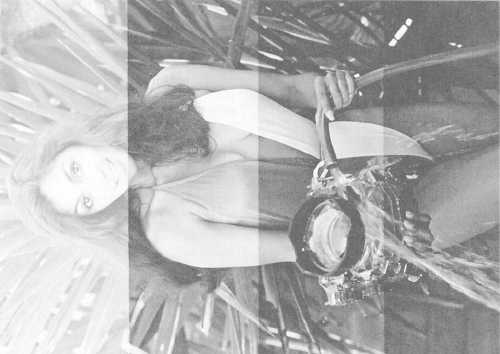PH2 Noel R. Guest
303.49
Figure 11-5.–A processed test strip used to determine exposure.
When a change in exposure time does not produce
a print of good contrast, a different printing filter is
needed. When a properly exposed and developed test
print lacks clean highlights and shadows, try a higher
number of printing filter. When the print is mainly black
and white with few middle tones, use a lower number
filter. Once you have produced a satisfactory test print,
you can make the production prints from that negative.
If you use a printing frame (glass and pad or proof
printer) to make contact prints, the most convenient and
economical way to determine exposure and correct
contrast is to expose the test strip in progressive steps of
say 2, 4, 6, and 8 seconds. You do this by holding an
opaque card on top of the glass and covering three
quarters of the paper and exposing one quarter of the
paper for 2 seconds. Then move the card to cover one
half of the paper and give it an additional exposure of 2
seconds. Move the card so it covers one quarter of the
paper and give it another 2 seconds of exposure. Finally,
remove the card and give the entire sheet one last
exposure of 2 seconds. This shows a distinct progression
of exposures of 2, 4, 6, and 8 seconds (fig. 11-5).
Develop the test strip normally. To determine the correct
exposure, you must examine the test print under white
light.
When the correct exposure appears to be between
two steps, the required exposure can usually be
estimated with some accuracy; however, additional test
prints may be needed.
After the exposure time and contrast for one
negative have been determined by tests, other negatives
of similar density and contrast can be given the same
filtration and exposure as a starting point. At first,
negatives with widely differing contrast and density
require test prints. With experience, you can judge most
negatives without resorting to test prints.
Exposing and Processing Prints
When a test print develops in the recommended
time, rinse it in the stop bath, immerse it in the fixing
bath for about 30 seconds, rinse it in fresh water, and
inspect it carefully under white light. When the density
and contrast of the image look correct under white light,
make your first “straight print.”
Place the sheet of printing paper, emulsion-side
down, over the negative in the printing position by
aligning the edges of the paper with the paper stops on
the mask (if a mask is used). With one hand, hold the
paper in the printing position with one hand to keep it
11-6

